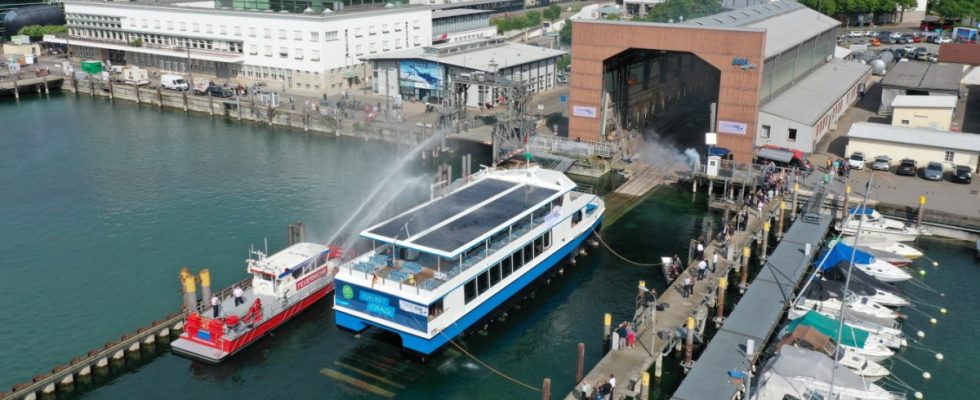The MS Mainau Island is a catamaran with space for 300 passengers. 30 meters long, eight meters wide, with a top speed of 15 kilometers per hour, the passenger ship sails on Lake Constance in summer and produces green energy using solar cells on the deck. The MS Mainau Island is the youngest and first electric fleet member of Lake Constance Shipping (BSB) – and therefore something of a symbol of the desired turning point on Lake Constance. The BSB has decided that its commercial shipping operations should be climate-neutral by 2035. Politics in the neighboring states of Germany, Austria and Switzerland have set the target for 2040. A feasibility study that has just been published on behalf of the Free State of Bavaria shows how this should work.
Private and commercial shipping on Lake Constance causes CO₂ emissions of around 52,000 tons annually. The body of water is Europe’s largest drinking water reservoir and there is an urgent need for action from an ecological perspective: The water is getting warmer and warmer, on the surface but also in the depths. One of the consequences of this is that the lake no longer mixes sufficiently, meaning that the oxygen-rich water is no longer flushed into the depths in late winter. Too little snow, low water levels in summer – the Lake Constance ecosystem is under stress.
According to the study, more than 38,000 boats with combustion engines are registered on the water, with 90 percent of the CO₂ emissions being caused by three categories of ships: the almost 14,000 motorsport boats with an output of more than 37 kilowatts, and ferries that operate all year round are in operation, and the seasonal, predominantly tourist-used passenger ships. When it comes to the technical implementation for ferries and passenger ships, Christoph Witte, technical manager at Bodensee-Schiffsbetriebe, had a lot of headaches a few years ago. “I no longer have that, we have made significant technological leaps.”
This of course includes the e-ship Mainau Island, but Witte also has a plan for other types of boats. In total, he says, the company is responsible for consuming six million liters of diesel per year. In Witte’s opinion, short distances driven at slow speeds will work “wonderfully” with fully electric power. There is an increase in the capacity of the batteries and sufficient fast charging capability. Methanol is emerging as a suitable fuel for large ships and faster speeds. This can be used via fuel cells, but also in modified combustion engines. Even the old, often listed ships on Lake Constance could be converted. “Technically the problems have been solved,” says Witte. “Financially we still have a problem.” He criticizes, for example, that the funding rates for bus fleets are higher than in shipping.
Technically there are solutions. Cost is a problem
So politics has to play a part, not just when it comes to funding. This is traditionally more complicated on Lake Constance because three states and many federal states and cantons are involved. They are organizing themselves in the so-called International Lake Constance Conference (IBK), which Bavaria was currently chairing. At the beginning of December, the new Bavarian European Minister Eric Beißwenger (CSU) not only sent “a clear signal for a climate-neutral future of Lake Constance shipping” in the Munich Residence, but also passed on the IBK chairmanship to the Swiss canton of Appenzell Innerrhoden. With the study on climate-neutral shipping, concrete figures are now available as a basis for decision-making for further measures, said the local mayor Roland Inauen on the occasion. “We want to continue to work intensively in our year as chairman to ensure that a traffic turnaround around and on Lake Constance is initiated in the near future.”
In Witte’s spirit, the feasibility study shows that e-methanol and battery-electric drives play an important role and that different strategies are needed for different ship types and interest groups. However, the e-methanol must be produced and transported to regions with lots of wind and sunshine, and the charging infrastructure for e-ships on the lake must also be expanded. Tests are underway with various promising fuels, including the MS Lindau and the MS Munich – However, e-petrol or e-diesel will not be available for some time.
This is exactly a problem for recreational vessels. “Many owners of large ships with large engines are hoping for e-fuels,” says Richard Leiner. “But they won’t be available before 2040.” Leiner is a retired professor of electrical engineering at the University of Konstanz and was responsible for the research boats there. He is co-founder of the Heureka Lago association, which has set itself the goal of emission-free shipping on Lake Constance. However, he considers the politically announced deadline for decarbonization by 2040 to be unrealistic.
A club is calling for a speed limit on the lake
The leisure boats consume more than eleven million liters of fuel with an output of more than 37 kilowatts. Taking all the owners with him during the transformation is the biggest challenge for him. Sailing boats, for example, are easy to convert to electric drives. In the medium term, Leiner is also relying on methanol for motorboats, although one solution in particular would help in the short term – a speed limit on the lake. Heureka Lago has submitted a petition for a speed limit of 15 kilometers per hour on Lake Constance. “That would significantly reduce fuel consumption.” Leiner also supports demands from politicians to no longer allow boats with combustion engines. Clubs could no longer give berths to such boats.
Leiner does not want to recognize the beacon character that politicians repeatedly mention when they praise climate-neutral shipping on Lake Constance. In Bavaria, for example, he says, there are many lakes where combustion engines are banned. “We are lagging a bit behind on Lake Constance.”

